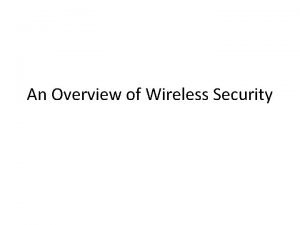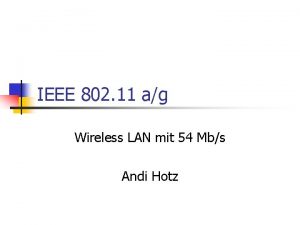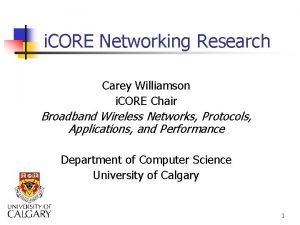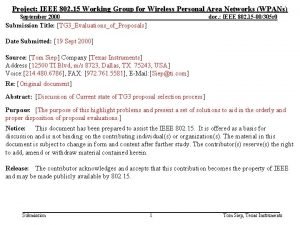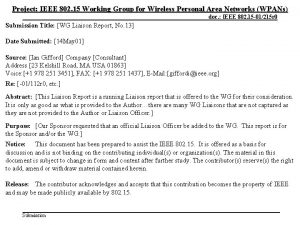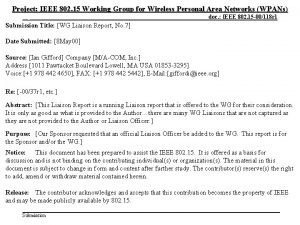Project IEEE 802 15 Working Group for Wireless





- Slides: 5

Project: IEEE 802. 15 Working Group for Wireless Personal Area Networks (WPANs) September 2004 doc. : 15 -04 -0542 -00 -004 b Submission Title: [Beacon scheduling MAC hooks] Date Submitted: [15 Sept 2004] Source: [Monique Bourgeois Brown] Company [Motorola, Inc. ] Address [1150 Kifer Road, Sunnyvale, CA 95131, USA] Voice: [+1 408 991 7460], E-Mail: [m. bourgeois@motorola. com] Re: [15 -04 -0234 -11 -4 b] Abstract: [How to use the existing 15. 4 MAC to enable beacon scheduling] Purpose: [To illustrate design of 15. 4 MAC to support beacon scheduling mechanism in the next higher layer. ] Notice: This document has been prepared to assist the IEEE 802. 15. It is offered as a basis for discussion and is not binding on the contributing individual(s) or organization(s). The material in this document is subject to change in form and content after further study. The contributor(s) reserve(s) the right to add, amend or withdraw material contained herein. Release: The contributor acknowledges and accepts that this contribution becomes the property of IEEE and may be made publicly available by 802. 15. Submission Monique Brown, Motorola, Inc.

September 2004 doc. : 15 -04 -0542 -00 -004 b Beacon Scheduling Support in IEEE 802. 15. 4 Monique Bourgeois Brown Motorola Labs Submission 2 Monique Brown, Motorola, Inc.

September 2004 doc. : 15 -04 -0542 -00 -004 b Beacon Scheduling Support in 15. 4 The 802. 15. 4 MAC was designed to include hooks for implementing beacon scheduling at the next higher layer. Proposal: Let’s use what we have! Existing hooks: 1. During a scan, a coordinator learns when each neighbor transmits beacon – MLME-BEACON-NOTIFY. indication contains a timestamp telling the next higher layer when neighbor’s beacon was received 2. MLME-START. request used by the next higher layer of coordinator to begin its own beacon transmissions 3. Coordinator knows when it transmits own beacon – contained in mac. Beacon. Tx. Time Submission 3 Monique Brown, Motorola, Inc.

September 2004 doc. : 15 -04 -0542 -00 -004 b What’s needed in 15. 4 b One change is necessary: MLME-START. request requires a Start. Time parameter to instruct the MAC on when to begin beacon transmissions. Start. Time parameter should be same format as Rx. On. Time parameter in MLME-RX-ENABLE. request. This approach has no issues with • Scalability • Backwards compatibility It addresses the needs of low duty cycle (15. 4) applications. Submission 4 Monique Brown, Motorola, Inc.

September 2004 doc. : 15 -04 -0542 -00 -004 b Coordinator Superframe Structure Every beaconing coordinator has its own superframe structure consisting of the beacon, CAP and, optionally, an inactive period. SO=0; 6 BO 10 yields duty cycle between <2% - ~ 0. 1% Coordinator A (parent) Inactive portion Coordinator B (child of A) Parent beacon tracking (optional at higher layer) Coordinator C (child of A) Start. Time of C may be chosen using knowledge of A, B gained through scanning. Submission 5 Monique Brown, Motorola, Inc.


